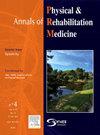Pragmatic multicenter randomized controlled study on early supported discharge after stroke in Korea: the KOMPACT study
IF 4.6
3区 医学
Q1 REHABILITATION
Annals of Physical and Rehabilitation Medicine
Pub Date : 2025-09-18
DOI:10.1016/j.rehab.2025.102025
引用次数: 0
Abstract
Background
Early supported discharge (ESD) has shown benefits in post-acute stroke care in Western countries; however, its effectiveness in Asian healthcare systems remains unclear.
Objectives
To investigate the efficacy and economic impact of ESD compared with conventional rehabilitation (CR) in Korean patients recovering from acute stroke.
Methods
The Korean Model for post-acute comprehensive rehabilitation (KOMPACT) study was a multicenter, single-blind, randomized controlled trial. Patients with mild-to-moderate stroke (modified Rankin Scale 1–3) were randomly assigned to the ESD or CR groups. ESD included 4 weeks of home-based rehabilitation and liaison services, including welfare applications and community care. Outcomes were assessed at baseline, 1 month after discharge, and 3 months after stroke. T-test, Chi-Square test, and Fisher’s exact test were used to compare the outcomes between two groups.
Results
Sixty-seven patients were enrolled, 61 (mean [SD] age, 66 [12] years, female n=13) of whom completed the study. No significant differences were found in the clinical outcomes, including functional dependence, between the groups. The ESD group (n=30) showed greater improvement in depressive symptoms from baseline to 3 months than the CR group (n=31) (p=0.025). Length of stay (17.8 days vs 18.3 days) and total deductible costs (2657.3 US dollars vs 2140.5 US dollars) did not significantly differ between the groups. However, one hospital site reported significantly lower rehabilitation costs for ESD. Patient and caregiver satisfaction were significantly higher in the ESD group in most domains.
Conclusion
ESD for Korean patients recovering from mild-to-moderate acute stroke showed clinical and economic outcomes comparable to those of CR, with potential benefits of mood improvement and higher patient satisfaction. These findings suggest that ESD could be a feasible transitional care model in the Korean healthcare system. Nonetheless, further research with larger sample sizes and more extended follow-up periods is needed to confirm ESD’s long-term effects.
Registrations
URL: https://www.clinicaltrials.gov; Identifier: NCT04720820
韩国脑卒中后早期支持出院的多中心随机对照研究:KOMPACT研究。
背景:早期支持出院(ESD)在西方国家急性脑卒中后的护理中显示出益处;然而,它在亚洲医疗保健系统中的有效性尚不清楚。目的:探讨ESD与常规康复(CR)在韩国急性脑卒中患者康复中的疗效和经济影响。方法:韩国急性后综合康复模型(KOMPACT)研究是一项多中心、单盲、随机对照试验。轻中度脑卒中患者(修改Rankin量表1-3)随机分为ESD组或CR组。公共服务电子化包括为期四周的家居康复及联络服务,包括福利申请及社区照顾。结果在基线、出院后1个月和中风后3个月进行评估。采用t检验、卡方检验和Fisher精确检验比较两组间的结果。结果:共纳入67例患者,其中61例(平均[SD]年龄66岁,女性n=13)完成了研究。两组之间的临床结果(包括功能依赖)无显著差异。从基线到3个月,ESD组(n=30)的抑郁症状改善程度高于CR组(n=31) (p=0.025)。住院时间(17.8天对18.3天)和总可扣除费用(2657.3美元对2140.5美元)在两组之间没有显著差异。然而,一家医院报告说,ESD的康复费用明显较低。在大多数领域,ESD组的患者和护理人员满意度明显更高。结论:韩国轻中度急性脑卒中患者恢复ESD的临床和经济结果与CR相当,具有改善情绪和提高患者满意度的潜在益处。这些研究结果表明,在韩国医疗保健系统中,ESD可能是一种可行的过渡护理模式。然而,需要进一步研究更大的样本量和更长的随访时间来证实ESD的长期影响。注册:网址:https://www.Clinicaltrials: gov;标识符:NCT04720820。
本文章由计算机程序翻译,如有差异,请以英文原文为准。
求助全文
约1分钟内获得全文
求助全文
来源期刊

Annals of Physical and Rehabilitation Medicine
Medicine-Rehabilitation
CiteScore
7.80
自引率
4.30%
发文量
136
审稿时长
34 days
期刊介绍:
Annals of Physical and Rehabilitation Medicine covers all areas of Rehabilitation and Physical Medicine; such as: methods of evaluation of motor, sensory, cognitive and visceral impairments; acute and chronic musculoskeletal disorders and pain; disabilities in adult and children ; processes of rehabilitation in orthopaedic, rhumatological, neurological, cardiovascular, pulmonary and urological diseases.
 求助内容:
求助内容: 应助结果提醒方式:
应助结果提醒方式:


